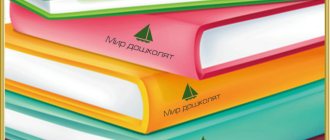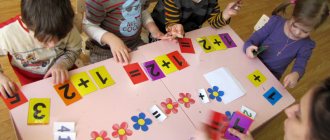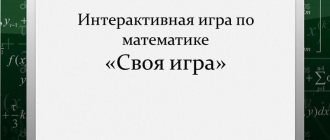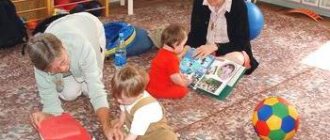Summary of a lesson on the formation of elementary mathematical concepts on the topic: “Oval”
Attached to each carriage is a card with a picture made up of geometric shapes drawn on the tickets:
— I am a cashier at a railway ticket office. Each of you will receive a ticket. Then you need to find your carriage. To do this, take a close look at your tickets. If you find the same geometric shapes on the carriage, then this carriage is yours.
While the children are looking for their seats, the teacher takes on the role of conductor (puts on a cap, takes a bag, attaches a badge). The children get into their carriages.
— Has everyone taken their seats? (Yes).
- Now I am a conductor. Show your tickets.
The teacher checks the “tickets”.
Subtotal:
Well done guys, everyone managed to get on the train because they correctly identified the geometric shapes. We can go.
The audio recording “Knock of Wheels” is played.
- Guys, we've arrived!
3. Difficulty in a game situation.
Goal: organizing an analysis by children of the situation that has arisen, leading them to identify the location and cause of the difficulty.
Requirements:
- creating a situation of difficulty;
- fixation in speech of the cause of the difficulty.
Children are “met” by the inhabitants of the country of Geometric shapes (triangle and square). Under the magnet next to them is a piece of paper with a task.
— Guys, do you think the inhabitants of the country of Geometric Shapes are happy to see us? (Yes).
- How did you guess? (They smile at us).
- Of course, the residents are happy, because you came to help them!
- Let's ask the residents how to help them! (The children ask, but the circle and square are silent).
- Learned? (No)
— How do you know how to help residents? (Guess), (See for yourself what needs to be done), (Read what is written in the note).
The teacher reads the note:
“Put things back where they belong, in boxes.”
Game "Putting objects in place"
The children sit at the tables. On the tables there is a “box” (a large circle) and “things” - round-shaped objects: a wheel, a watch, a plate, a coin, a tray, a sponge, a steering wheel, cookies, a steering wheel, a CD, a cutting board, a lifebuoy. The size of the small circles is such that they fit into an oval. There are also oval-shaped objects according to the number of children - a watch, a mirror, a piece of bread, a tray, a plate, a sponge, a napkin, a wooden cutting board, a plastic cutting board, a rug.
— What shape is the box? (Round).
- This means that round objects must be put in it.
— Put these items in the box. (the teacher points to a circle cut out of a landscape paper)
Children place round objects in a circle, but cannot place oval objects.
— Are all things in place now? (No).
—You couldn’t put all your things away? (Failed).
- Why? What's the problem? (There are things that are not round, the mirror does not fit into the box).
- Why can't we put these things in a round box? (Because it is of a different shape; the napkin is not round).
“You couldn’t remove all the things and help the residents.”
The teacher pauses long enough for the children to comprehend the situation of difficulty.
—Are you in a difficult situation? (Yes).
- Discovery of new knowledge.
Goal: organizing a dialogue between the teacher and children aimed at discovering new knowledge.
Requirements:
- organizing an introductory dialogue in order to discover new knowledge;
- fixation of new knowledge in speech and symbolically;
- creating a situation of success.
Game "Find the box"
- What do we do? (Let's pick a box for these items).
If the children find it difficult, the teacher continues the introductory dialogue:
— You put round objects in a round box. Items that you were unable to remove have a different shape. Can you find a suitable box for it? (Yes).
- Pick it up.
Children go to another table, on which there are squares, triangles, circles and ovals cut out of colored cardboard. There are as many ovals as there are children.
— Guys, choose a suitable box and put the items in it.
Children choose the desired “box” and sit down.
— Now all the items are put away in boxes? (Yes).
- Count how many round objects you have? (Four).
— How many non-round objects do you have? (One).
Subtotal:
Well done, you managed to tidy up because you picked suitable boxes for both round and oval items.
The teacher tells the children that the inhabitants of the country of Geometry thank them and give them a gift - a box with ovals. Children each take an oval,
The teacher hangs an oval on the board.
- Do you want to play with them? (Yes)
- Look at the oval.
- Circle it with your finger (children circle the oval).
-What did you notice? (an oval has no corners)
- What other figure does not have corners? (at the circle)
— How does an oval differ from a circle (an oval is elongated, and a circle is smooth)
We know that the circle rolls well (the teacher shows how the circle rolls)
— Try to roll an oval (children roll an oval).
— The oval also rolls well (no).
- Let's hide the oval (children “hide” the oval under a sheet of paper)
The teacher shows the ellipsoid.
- Is this an oval? (Not really)
- Let's try to hide it (the children are trying to hide the ellipsoid under a sheet of paper).
— Did you manage to hide this figure? (No)
- That's right, this figure is not an oval, an oval is flat.
The teacher points to the oval.
- Here is an oval - it is flat, elongated, without corners.
Summary: Well done guys, you understand what an oval is.
5. Inclusion of new knowledge into the knowledge system.
Goal: consolidate new knowledge in children through games and exercises.
Requirements:
- compliance of the games used with the purpose of the lesson;
- individual difficulties in games;
- situation of success in joint activities.
A rectangle appears with a sad face on it. He has a note.
— Another resident came to us. What do you think is his mood? (he is sad, cheerless)
- Ask why he is so sad?
- Why are you so sad?
(The children ask, but the rectangle is silent.)
- Learned? (No)
- How to find out? (Guess, read what is written in the note).
The teacher reads the note:
“I lost oval objects because I was lazy and didn’t put them back in their place.”
- Don’t worry about the rectangle, our guys will help you.
- Guys, can you help? (Yes)
Game "Collect objects"
The teacher is holding an oval-shaped box in his hands.
- Look carefully around, find all the oval-shaped objects in our group and bring them to this box.
Children look for oval objects laid out everywhere in a group (mirror, rug, sponge, napkin, etc.)
Subtotal:
Well done boys. You completed the task and found all the lost oval objects.
When children find all the oval objects, they give the box to the rectangle. The rectangle has a joyful face. He has a note.
- Look, guys, another note. Let's read it.
The teacher reads the note:
"Thank you guys. I will never throw my things around again. Because you helped me, I want to give you a cartoon.”
Children watch the cartoon "Geometric Shapes".
— Guys, did you like the rectangle gift? (Yes)
“Now it’s time for us to go back to kindergarten.” Take your seats on the train.
The sound of wheels sounds in the recording, the children return to kindergarten.
- Summary of the lesson.
Goal: organizing reflection and self-assessment of children’s activities.
Requirements:
- organization of analysis of children's goals;
- fixation of new knowledge in speech;
- determining the fulfillment of an adult goal.
Children sit on chairs.
- Guys, where were we today? (in the country of Geometry)
- Why did we go there? (help residents clean up)
— Were we able to help the inhabitants of the country of Geometry? (Yes)
- Why did you succeed? (we know geometric shapes, we know colors, we can count, we are kind)
- What geometric shape did we meet today? (oval)
“We completed all the tasks because we know geometric shapes, we know colors, we can count, because we are attentive, kind guys. Well done!
Lesson summary on FEMP in the middle group “Rectangle”
LESSON 11
RECTANGLE
Purpose of the lesson
Introduce children to a rectangle, teach them to distinguish between a square and a rectangle; continue to teach how to arrange objects in a row in ascending order of width; develop the eye, practice counting within four
Objectives
:
give children an idea of a rectangle and its difference from a square. Develop the ability to compare a square and a rectangle. Develop the ability to create geometric shapes from counting sticks. Strengthen the comparison of objects by width, repeat the names of colors, develop fine motor skills. Cultivate a friendly attitude towards each other.
Materials
For the teacher: Parsley, a circle and a rectangle made of thick paper.
For children: each child has counting sticks, a rectangle
, square, triangle of different colors, three stripes, equal in length, decreasing in width.
Progress of the lesson
1. Organizational moment
-Children, Parsley came to us today. He brought us figures, but he doesn’t know what they are called. Let's help him figure it out.
Look what he brought.
The teacher shows a rectangle.
2. Report the topic of the lesson
Today we will talk about rectangle
3. Main part
-Who can name this figure? What is this?
The teacher listens to the children's answers and, if necessary, suggests the correct answer. There is a rectangle and a square on the board.
— What is the difference between a rectangle and a square?
After the children’s answers, the teacher clarifies how these figures differ: a square has all equal sides, and a rectangle has equal top and bottom, left and right (side) sides.
- Show Petrushka the square. Can a square roll like a circle? What's stopping him? What are the sides of a square?
- How can you see that a square and a rectangle have corners? (put a circle on top) - How do you know that a rectangle has two longer sides, and a square has all sides equal? (lay out from sticks) Construction of geometric shapes from sticks. - How many sticks did you take to build a square and a rectangle? Did you see that the rectangle has two long sides and two short ones?
(It is necessary that children not only answer that the sides of a square are equal, identical, but also, at the request of the teacher, can
check it out).
— Show Parsley the rectangle. What figure did you show?
Practice the children saying this word.
— What can you tell parsley about the rectangle:
Several children, if desired, tell parsley about the difference between a rectangle and a square and a circle.
Game
“Show a figure like mine”
Guys, Parsley brought us not only squares and rectangles
, remove the triangle from the plates.
Place a rectangle
, square and triangle in front of you in a row.
Now we will play the game “show me a figure like mine.”
I show one rectangle
, square and triangle
-What figure did you show me?
-What color is it?
- And I have a rectangle (square, triangle)
what colour?
- Now collect all the figures on the plates and let’s rest a little.
Physical minute “Wild animals”
Let's get up, we need to rest, (Get up from the chairs) Shake our fingers. (Clenching and unclenching your fingers) Raise your hands up, (Place your palms on your head with your fingers up) Move your fingers, (Move your palms forward and back) This is how little gray bunnies move their ears. We sneak quietly on our toes, (Walking in place on our toes, smooth, like foxes roaming through a forest. movements with our hands in front of us) The wolf looks around, (Hands on the belt, turns our heads And we turn our heads. left - right) Now we sit down more quietly, more quietly, (Squat down) Let's be quiet, like in a mouse hole. A bear walked through the forest, (Waddled, arms bent in front of him, stomped and growled. Elbows) He really wanted honey, But he didn’t know where to get it. (Raise your shoulders up, look questioning)
Comparison by width
Remove the strips from the plates and arrange them in order from narrowest to widest.
—Where will we trim the stripes? (up)
—Which strip is the narrowest? (brown)
—Which strip is the widest? (red)
—Which stripe is already green or orange? (brown stripe is narrower than orange)
—Which stripe is wider, orange or brown? (orange stripe is wider than green)
—Which stripe is already orange or red?
—Which stripe is wider, red or orange?
- Name the stripes from narrowest to widest. (points with finger - narrowest, wider, widest)
.
Finger gymnastics
| Bunny Gray bunny sitting And he wiggles his ears. We need to warm our paws, It's cold for the bunny to sit. | Hands clenched into fists. Extend and bend your fingers. Rub your fingers and hands. |
Trace and paint
4. Summary of the lesson
- Tell me what geometric figure we met today in class
?
- What geometric figure did we compare the rectangle
?
— How did we lay out the strips?
“You guys were all great, you completed all the tasks and helped Petrushka figure out geometric shapes.”




